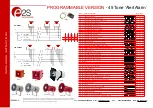
©
Agilent Technologies 1989–2002
Agilent 3070 / 79000 Site Preparation
7-2
Chapter 7: Site Preparation – Compressed Air and Vacuum Requirements: Compressed Air Requirements
Compressed Air
Requirements
This section contains:
■
Connecting Air to the Testhead
■
■
The Agilent 3070 / 79000 family uses compressed air to
pressurize air cylinders that actuate fixture pull-down
towers. Pull-down towers are used to pull and hold a
fixture down onto the testhead, enabling contact
between the pins on the fixture and the spring-loaded
interface pins in the testhead.
Compressed Air Specifications
shows the compressed air specifications for
the 3070 / 79000 family systems. The air flow rates
when using Performance Port are the maximum that
could be needed. Some installations might require lower
volumes.
Connecting Air to the Testhead
Install compressed air lines using rigid line to a point
near the testhead. An air cutoff valve is recommended
for situations when the air line must be disconnected.
When the system is installed, connect the air to the
testhead with a flexible line that has a Hansen Series
Table 7-1
Compressed air specifications for 3070 / 79000 systems
Description
Measurement
Maximum Pressure for Testhead Only
1035 kPa (150 psi)
Minimum Pressure for Testhead with Performance Port
690 kPa (100 psi)
Minimum Pressure for Testhead Only
480 kPa (70 psi)
Minimum Flow Rate for Testhead Only
0.66 l/s at STP (1.4 SCFM)
1
Minimum Flow Rate for Testhead with Performance Port
7.1 l/s at STP (15 SCFM)
Relative Humidity allowed
70% for compressed air (150 psi) at 25 degrees C
50% for compressed air (150 psi) at 40 degrees C
Dew point must be not more than 5 degrees C
1. l/s is liters per second. STP is standard temperature and pressure. SCFM is standard cubic feet per minute. See the
















































